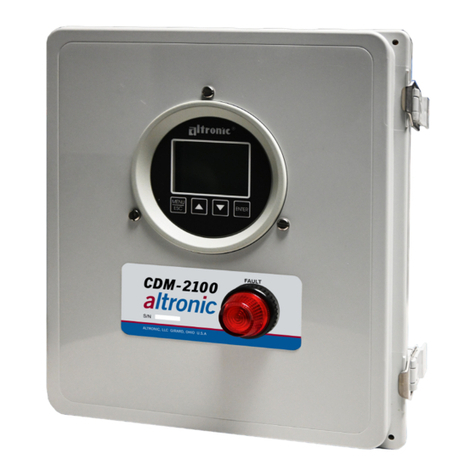
-8-
10.3 "AUTO SCAN” - Allows the user to display automatically, or manually, the selected number
of points. The scan starts with channel 01 and progresses in numerical order to the last
channel selected in configuration. In manual scan, the device continually displays the
temperature value of one channel at a time. The next channel or previous channel and
corresponding temperature value is displayed with each press of the or arrow key.
In auto scan, the device will display each channel number and temperature value for
approximately two seconds before automatically switching to the next channel. The or
arrow keys can be used in auto scan to quickly advance or descend to other channels.
10.4 "THERMOCOUPLE / J or K” TYPE - The instrument can read either type J or K
thermocouples. Use the or arrow key to select a thermocouple type and press
ENTER/ACK to accept and save the new thermocouple type.
NOTE: Pressing ENTER/ACK will return all of the adjustable parameters, including the
setpoint switch values, to factory default values. When verifying the type, press ESC to exit
without reloading default values. All thermocouple inputs must be either type J or K; the
inputs cannot be mixed.
10.5 "FILTER VALUE / 1-255" DISPLAY FILTER - The display filter can be used to stabilize the
display reading of a changing input. Filtering is done in both hardware and software. The
software filter is an adjustable filter; the rate of change is less for large values. The filter
value is read-out in a number from 1 to 255, 1 being minimum filter value and 255 being
maximum filter value. Below are some typical filter values and their effect on the display
reading. Settling values are approximate times in seconds to reach 90% of new reading.
Use the or arrow keys to increase or decrease the filter value and press ENTER/ACK
to save the new filter value.
FILTER VALUE 1 128 200 210 220 230 240 250 253 255
SETTLING, SEC. 1.6 2.0 2.5 3.5 4.0 6.0 11 30 58 176
10.6 "CALIBRATE" - For calibration procedures, see Section 12.0.
10.7 "SETPOINT PROTECTION / OFF or ON” - This feature allows the user an added layer of
protection by preventing the setpoints from inadvertently being changed. When protection
is ON, the user is able to view the setpoint values but is not able to change any of them.
If an attempt is made to change the setpoint values and the ENTER key is pressed when
protection is on, the display will read "LOCKED" and return to the normal display mode.
10.8 "NODE NUMBER / 1-99" RS-485 COMMUNICATIONS NODE NUMBER - For RS-485
serial communications, each unit must be assigneda node, or identification number, so that
a DSM device can be identified by the device communicating with it. Any unique number
from 1 to 99 may be used.
10.9 “SERIAL COMMS” - This configuration sets up the serial communication type and
parameters. The selections are: DSM ASCII 9,600 baud N 8 1 or MODBUS RTU 9600,
19200, 38400, 57600 baud rate N 8 1.
10.10 “SENSE LINE” - All setpoints and output switches can be inhibited during start-up by using
the sense line. Lock-out can occur with either an external contact closure or by sensing
pulses from a pickup monitoring gear teeth. Use the or arrow key to pick either “DRY
CONTACT” or “PULSED PICKUP”.






























